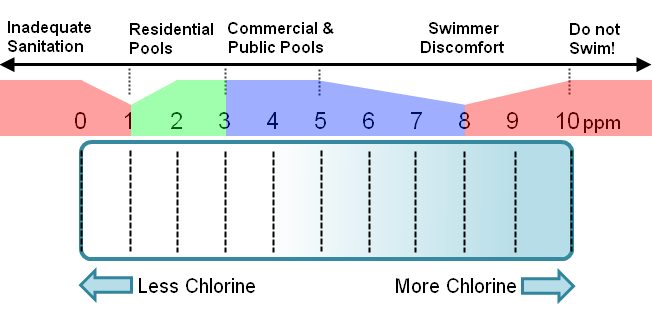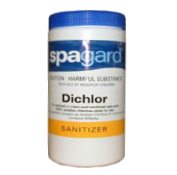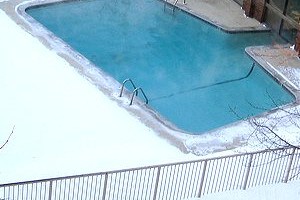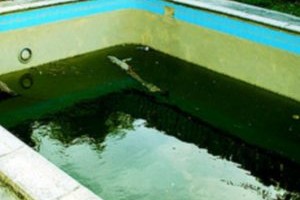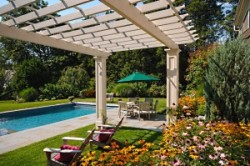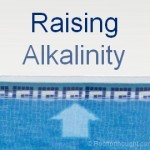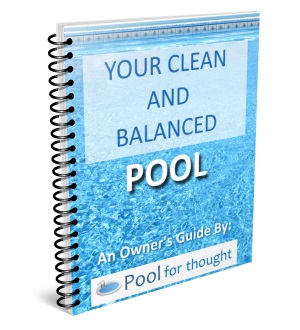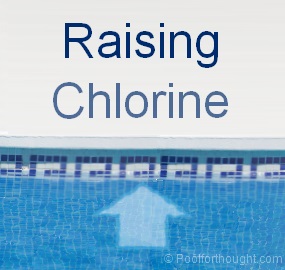
If you own or operate a chlorinated swimming pool, you will often be faced with raising the pool water chlorine level. The free chlorine in your pool water is what performs the sanitizing and oxidizing duties, which contaminates in the pool water and sunlight both contribute to reducing the free chlorine available in the pool water. So, unless you are adding chlorine into your pool at a constant rate, the amount of usable chlorine in the pool water is continuously decreasing.
In this article, I explain how to increase your swimming pool water chlorine level, and describe why this level is important and why you need to prevent the level from getting to low. I also explain more about swimming pool chlorine maintenance in my articles: Maintaining Swimming Pool Chlorine, and Testing Pool Chlorine. If you need to decrease the amount of chlorine in your pool, you can learn the ways here: Lowering Swimming Pool Chlorine.
Importance for your pool
Why is raising swimming pool chlorine important?
If your pool at least partially relies on chlorine as a sanitizer and you find your chlorine level to be low, then it is critical you adjust the chlorine level up.
You generally want to maintain a level of 1 – 3 ppm (parts-per-million) of chlorine in your pool, although for commercial pools they generally need a level of 3 – 5 ppm. The low limit of 1 ppm is important, as levels less than 1 ppm are not effective at keeping the water sanitized. Because of this, experts often recommend you keep your residential chlorine level at 2-3 ppm. The diagram below shows where your home swimming pool chlorine level fits in a chlorine range of 0 – 10 ppm:
[sc:ad_leaderboard_google]Why raise the pool chlorine level?
If you do not keep keeping the appropriate level of chlorine in your water, you risk having unsafe pool water from bacteria growth, algae growth, and can end up with costly chemical bills as you try to restore the balance and chlorine level in the water.
If your pool is only slightly under 2 ppm, then letting your chlorinator or chlorine feeder bring the level back up is ok. Add more tablets or granuals and increase chlorinator dial, then retest a day later.
If you test and discover your pool not longer has any chlorine, then you need to act fast. Algae and other microorganisms are free to grow and multiply in water without any sanitizer. The longer the pool water remains with no sanitizer, the more likely problems will appear and will be more difficult to reverse.
If you test your chlorine and discover you have combined chlorine in your pool, you will need to shock (superchlorinate) the pool. This will eliminate the contaminates showing up as combined chlorine in your test. Ideally, the free chlorine and total chlorine level should be the same. Any difference in these two indicates presence of combined chlorine.
Why is my pool chlorine level too low?
There are a number of factors which can contribute to low chlorine in swimming pool water. I discuss some of these in the article titled; Maintaining Swimming Pool Chlorine, but here are what you can expect to happen with swimming pool water with a chlorine level that is too low for an extended amount of time:
- Microbe and bacteria growth.When the chlorine level is too low, microorganisms like bacteria are able to multiply faster. With harmful bacteria like e-coli, this will quickly cause your pool to be unhealthy, risking any swimmers potentially getting sick.
- Algae growth.Algae will also grow quickly. Although you may also be adding algaecides to the pool water, keeping an adequate chlorine level helps prevent algae from gaining a foothold in your pool. Some algae types like mustard algae or black algae are difficult to remove once they have established a presence in your pool water.
- Cloudy, murky, or milky water.With little to no chlorine in the pool water, contaminates that would normally be oxidized by chlorine instead build up in the pool water. The result is the water loses its clarity and sparkle.
- Water balance problems.Bringing the chlorine level back up by applying a shock treatment can alter the water balance in the pool. You may also have to adjust water balance levels like total alkalinity, pH, and calcium hardness after drastically raising the chlorine level.
- More expense and maintenance.You will end up shocking the pool at least once, sometimes twice to rid the pool of combined chlorine. Shock is expensive and time consuming, plus the high levels of chlorine in the pool water from shocking prevent swimmers from safely entering the water, and high chlorine levels can degrade vinyl-lined pool walls over time. So, you want to minimize shocking whenever possible. Keeping your chlorine level in the ideal range is a key way to avoid these unneeded shock treatments.
How to raise your swimming pool chlorine
You first need to test your existing pool chlorine level to determine if you just need a slight adjustment or if you need to shock the pool in cases where you have combined chlorine in the water.
Do you already have a chlorinator, chlorine feeder, or chlorine floater? If so, you will be adding your chlorine to this device. If you typically add chlorine directly into your skimmer, stop doing this (unless you are using chlorine specifically designed for this). Adding regular chlorine pool products to your skimmer causes the chlorine in the water travelling to your pool equipment to drastically rise and reduce your pH level, making the water passing through the pool equipment corrosive. This will damage your pool equipment over time, causing corrosion and introducing unwanted metals like copper into your pool.
There are several variations of chlorine you can add to your pool:
Raising Chlorine with Trichlor tablets, sticks, or granules
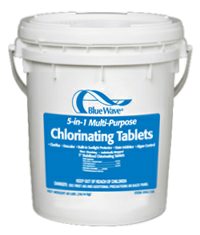
Trichlor chlorine is popular for outdoor chlorinated pools.
Trichlor, or Trichloroisocyanuric Acid, is the most popular chlorine additive for pool owners.
Some of it’s advantages:
- Dissolves slowly in contact with water, making this idea for chlorinators, feeders, and floaters.
- Available in a variety of forms; tablets or pucks, sticks, and granules.
- Low cost compared to other forms of stabilized chlorine.
A few disadvantages of using trichlor:
- Very concentrated. It can burn skin and mucous membranes with minimal exposure. Stand upwind and avoid breathing in fumes when working with trichlor.
- Highly acidic, having a pH of about 2.8 – 3.5. This puts pressure on your pool pH, and can lower your total alkalinity.
- You may need to add soda ash (sodium bicarbonate) more often to counter the affects of low total alkalinity.
- Low alkalinity can cause corrosive damage to the pool walls and equipment, so additional testing is needed.
- Raises the cyanuric acid of your pool water over time.
Raising Chlorine with Dichlor granules
Dichlor, or Sodium Dichloroisocyanurate, is also popular, but is used more for above-ground pools and spas.
Some advantages of dichlor:
- Fast dissolving. Great for times when a quick dose of chlorine is needed prior to using the pool.
- Only a slight affect on pH, which is about 6.7, and is also good for spas where pH is notoriously hard to control.
- Does not have any effect on total alkalinity.
A few disadvantages of using dichlor:
- More expensive than trichlor.
- Not recommended for chlorinators, feeders, or floaters as it dissolves too fast.
Raising the chlorine level by shocking the pool
Stabilized versus Unstabilized Chlorine
The type of chlorine you routinely add to your pool will likely be stabilized chlorine. This is chlorine with cyanuric acid added to the chlorine which increases the time the chlorine will stay stabilized in sunlit pool water. The addition of cyanuric acid helps maintain chlorine levels in outdoor pools up to three to five times versus adding unstabilized chlorine. Unstabilized chlorine does not have a cyanuric acid added to the chlorine and must be added separately.
When you shock the pool with chlorine-based shock, this is typically made of unstabilized chlorine, as adding stabilized chlorine to shock the pool would increase the cyanuric acid levels of the pool too much.
Tips on adding chlorine to your pool:
- Stay with one variety of chlorine, as mixing products can make it difficult to maintain consistent chlorine levels in your pool.
- You can add regular retail liquid bleach, but there is no reliable way to determine how much chlorine will end up in your pool, as the shelf life reduces the chlorine effectiveness. So, we do not recommend using retail liquid bleach.
- If you are using the same chlorine you always have, then you can add without problems. If this is the first time adding chlorine, or you have switched brands or the type of chlorine, then you should add a portion, and retest the chlorine level to avoid adding too much chlorine. Adding too much chlorine can contribute to higher combined chlorine levels.
- If you use a chlorine floater, these tend to get pulled toward your skimmer. Depending on your pool configuration, you can tie the floater to one section of the pool, preferably where the water flow rate is high.
- Always keep chlorine on hand to avoid a gap in chlorine levels. If you use trichlor tablets for example, when you are getting to the bottom of your bucket, you need to make a trip to the pool retailer.
- If you test, or have tested, your cyanuric acid and it is getting to be high (at or near 80 ppm), then you have two choices:
- Drain part of the pool and replace with fresh water. This will reduce the cyanuric acid level.
- Add only unstabilized chlorine to your pool. This can be risky, as you would be adding a chlorine form that you typically do not add. You run the risk of adding too much or too little chlorine. Add small amounts and retest to get an idea of how your pool reacts to the unstabilized chlorine. Over time through backwashing and water that is splashed out or carried out by swimmers, the cyanuric acid will go down.
Conclusion
It’s important to know how to raise the chlorine level of your pool. Maintaining adequate sanitation is critical to maintain a safe swimming environment. You also need to know how you intend to add the chlorine and be familiar with the varieties available to you, and what devices are available to help keep a constant level of chlorine in your pool.
A chlorine-balanced pool will save money over the long term, as having a pool too low or too high results in more maintenance and more time and money spent adding chemicals and testing.
Source:
- “Pool & Spa Water Chemistry, A Testing and Treatment Guide, Waterproof Edition, 2005. Taylor”
